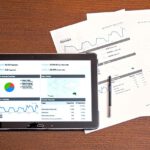In this blog post, we explore how businesses can leverage data and analytics to optimize conversion rate optimization (CRO) on Shopify Plus, ultimately increasing sales and customer satisfaction.
Understanding the Importance of Data and Analytics for CRO
Data and analytics play a crucial role in conversion rate optimization (CRO). CRO is the process of increasing the percentage of website visitors who convert into customers or take a desired action on the website. Data and analytics provide insights into customer behavior, preferences, and pain points, allowing businesses to make data-driven decisions to optimize their website and improve the user experience. Without data, CRO efforts are based on assumptions and guesswork, which may not yield the desired results.
By collecting and analyzing data, businesses can identify areas of improvement on their website, such as pages with high bounce rates, low conversion rates, or long load times. They can also track user behavior, such as the pages they visit, the products they view, and the actions they take. This information can be used to optimize website design, content, and functionality to better meet the needs and expectations of visitors.
Furthermore, data and analytics can help businesses identify the most effective marketing channels and campaigns for driving traffic and conversions. By tracking conversion rates and revenue generated from different marketing channels, businesses can allocate their marketing budget to the most profitable channels and optimize their campaigns to improve performance.
In addition, data and analytics can provide insights into customer segmentation and targeting. By analyzing customer data, businesses can identify their most valuable customers, their preferences and behavior, and create targeted marketing campaigns to better reach and engage them.
How to Collect and Analyze Data on Shopify Plus?
Collecting and analyzing data on Shopify Plus is essential for optimizing your online store's performance. Shopify Plus offers a range of built-in analytics tools that businesses can use to track customer behavior, monitor sales performance, and analyze marketing campaigns.
One of the most important tools for data collection on Shopify Plus is Google Analytics. By integrating Google Analytics with your Shopify store, you can track website traffic, user behavior, and conversion rates. This information can be used to identify areas of improvement on the website and optimize the user experience to increase conversion rates.
Shopify Plus also offers a range of built-in reports that provide insights into sales performance, customer behavior, and more. These reports can be customized to suit your business needs and provide valuable insights into key metrics such as revenue, average order value, and customer lifetime value.
Another way to collect data on Shopify Plus is through customer feedback. By collecting feedback from customers through surveys, reviews, or social media, businesses can gain valuable insights into customer preferences, pain points, and expectations. This information can be used to optimize the website, improve product offerings, and enhance the overall customer experience.
Once data has been collected, it needs to be analyzed to identify patterns and trends. Shopify Plus offers a range of tools for data analysis, including custom reports and dashboards. These tools allow businesses to analyze key metrics and identify areas of improvement in real-time, allowing for quick and effective decision-making.
In addition, third-party analytics tools can be integrated with Shopify Plus to provide advanced insights and analysis. These tools can help businesses gain a deeper understanding of their audience and optimize their website and marketing campaigns accordingly.
Which Metrics Should You Focus on for CRO?
When it comes to Conversion Rate Optimization (CRO), it's essential to focus on the right metrics to achieve your business goals. Here are some key metrics to consider when optimizing your Shopify Plus store for conversions:
- 1. Conversion Rate (CR):
The conversion rate is the percentage of website visitors who complete a desired action, such as making a purchase or filling out a form. A high conversion rate indicates that your website is effective at converting visitors into customers. Tracking your conversion rate is essential to identify areas of improvement and measure the success of your CRO efforts. - 2. Average Order Value (AOV):
The average order value is the average amount of money spent by customers on your website per order. Increasing the AOV can help boost your revenue and profitability. By tracking AOV, you can identify opportunities to cross-sell or upsell products to customers and optimize your pricing and product offerings. - 3. Cart Abandonment Rate (CAR):
Cart abandonment rate is the percentage of website visitors who add items to their cart but do not complete the purchase. A high cart abandonment rate indicates that there may be issues with the checkout process, pricing, or product descriptions. By tracking and analyzing the cart abandonment rate, you can identify and address these issues and optimize the checkout process to improve conversion rates.Other metrics to consider when optimizing your Shopify Plus store for conversions include bounce rate, time on site, and customer lifetime value. It's important to focus on the metrics that are most relevant to your business goals and use them to guide your CRO efforts.
"You can't improve what you don't measure." – Peter Drucker
Peter Drucker's famous quote is particularly relevant when it comes to Conversion Rate Optimization (CRO). In order to make meaningful improvements to your website's conversion rate, you need to measure and analyze key metrics to identify areas of improvement. Without data and analytics, it's impossible to know whether your CRO efforts are having a positive impact on your business.
Measuring and analyzing data is essential to identify areas for improvement and optimize website performance. By tracking and analyzing key metrics such as conversion rate, average order value, and cart abandonment rate, businesses can gain valuable insights into customer behavior and preferences, and identify opportunities to improve the website's performance.
In addition to measuring key metrics, it's important to set goals for your CRO efforts and track progress towards those goals. This can help to keep your team focused on the most impactful changes and ensure that you're making progress towards your business objectives.
By measuring and analyzing data, businesses can make data-driven decisions and optimize their website to drive conversions and improve business performance. Whether you're just getting started with CRO or looking to take your efforts to the next level, data and analytics should be at the core of your strategy.
A/B Testing: The Key to CRO Success
A/B testing, also known as split testing, is a powerful tool for optimizing website performance and driving conversions. This testing method involves creating two versions of a webpage and testing them against each other to determine which version performs better. A/B testing is essential to CRO success because it allows businesses to make data-driven decisions and optimize their website for maximum performance.
- The Benefits of A/B Testing:
A/B testing provides a number of benefits for businesses looking to improve their website's performance. By testing different elements of a webpage, such as headlines, images, and calls-to-action, businesses can identify which elements are most effective and make data-driven decisions to optimize their website. A/B testing can also help businesses to reduce bounce rates, increase time on site, and ultimately drive more conversions. - Best Practices for A/B Testing:
To get the most out of A/B testing, it's important to follow best practices and guidelines. One key best practice is to test one element at a time. This ensures that you can accurately measure the impact of each change and identify which elements are driving the most significant improvements. It's also important to have a large enough sample size to ensure that your results are statistically significant. - Tools for A/B Testing:
While A/B testing can be done manually, there are a number of tools available to help businesses streamline the process and get more accurate results. Many website builders, such as Shopify Plus, offer built-in A/B testing tools that allow businesses to easily create and test different versions of their website. There are also a number of third-party A/B testing tools available that provide more advanced features and functionality.
Utilizing Third-Party Tools for Enhanced Insights
While Shopify Plus offers built-in analytics and reporting features, businesses can also benefit from utilizing third-party tools for enhanced insights. These tools can provide more advanced analytics, deeper insights, and more robust reporting capabilities.
One popular third-party tool for analytics and reporting is Google Analytics. This free tool provides businesses with a wealth of data on website performance, including traffic sources, user behavior, and conversion rates. By integrating Google Analytics with Shopify Plus, businesses can gain deeper insights into their website's performance and identify opportunities for optimization.
Another popular third-party tool is Hotjar, which offers a range of features for website optimization, including heatmaps, session recordings, and surveys. These features can help businesses to identify areas of their website that are causing frustration for users, and make data-driven decisions to improve the user experience.
For businesses looking to optimize their website for search engines, tools like SEMrush and Ahrefs can provide valuable insights into keyword rankings, backlinks, and other important SEO metrics. By utilizing these tools, businesses can identify opportunities to improve their website's search engine visibility and drive more organic traffic.
Finally, for businesses that are focused on social media marketing, tools like Hootsuite and Sprout Social can provide valuable insights into social media engagement, audience demographics, and other important metrics. These insights can help businesses to optimize their social media strategy and drive more engagement and conversions.
How to Continuously Optimize Your CRO Efforts?
Optimizing your CRO efforts is an ongoing process that requires constant monitoring and experimentation. Here are a few tips to help you continuously improve your CRO efforts on Shopify Plus:
1. Set up a regular testing schedule:
A/B testing is a critical component of CRO, and it's important to have a regular testing schedule in place. This can help you identify trends and make data-driven decisions about what changes to make to your website.
- 2. Continuously monitor website performance:
Keep a close eye on your website's performance metrics, such as conversion rates, bounce rates, and average order value. This will help you to identify areas of your website that need improvement and make data-driven decisions about how to optimize your website.3. Use customer feedback to inform your CRO efforts:
Customer feedback is a valuable source of information when it comes to CRO. Use surveys, feedback forms, and other tools to gather feedback from your customers and use this information to inform your CRO efforts. - 4. Keep up-to-date with industry trends:
The e-commerce industry is constantly evolving, and it's important to stay up-to-date with the latest trends and best practices. Attend industry events, read industry blogs, and network with other e-commerce professionals to stay informed. - 5. Utilize Shopify Plus' built-in features:
Shopify Plus offers a range of built-in features to help businesses optimize their website for conversions, including abandoned cart recovery, discount codes, and email marketing. Make sure you're taking advantage of these features to get the most out of your website.
By understanding and implementing data-driven CRO strategies on Shopify Plus, businesses can make informed decisions to improve their online store's performance, resulting in increased conversions, sales, and customer satisfaction.







